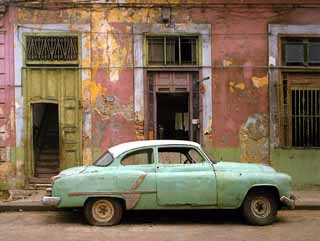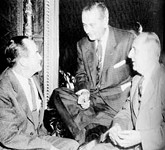Habana Viejo
Two photography books recall a city that has fallen apart
By Dick Holland, Fri., Dec. 14, 2001

When we think of Walker Evans, we remember his great days as a photographer for Roosevelt's Farm Security Administration, particularly his portraits of Alabama sharecroppers and his haunting landscapes of Depression-era American cities and small towns. But just prior to this period, Evans traveled to Cuba to take some photos that would illustrate a polemical book of the time, Carlton Beal's The Crime of Cuba. Evans' photographs of Havana street scenes and of a few small villages are now viewed as early masterworks, a group of images where he came into his own as a curiously personal documentarian. What Evans found in Havana was a great Caribbean metropolis, filled with handsome men and women and the mysterious overlapping of cultures common to a port city. His characteristic approach to portraits is casual yet always perfectly composed and expressive of both the subject and the setting. A photograph of a tall black man in a white suit is striking because of the subject's piercing eyes that seem to burn right through the camera's lens. His confrontational look and the dignity with which working men pose in other shots are a sharp contrast to the beaten-down Southerners Evans found in America only two years later.

In her introduction to Walker Evans: Cuba (J. Paul Getty Museum, $24.95), Judith Keller cites the influence of the Parisian photographer Atget, with his taste for deserted urban streets and antiquarian scenes that embody the history of a culture. The 61 prints reproduced in the book reinforce these influences, but also help us see Evans as fully himself -- his portraits have formal power, yet look unstaged. His scenes of the city are full of detail and quirks. Most of all, he captures the self-contained dignity of the Cubans and the concealed quality of their built environment. The Getty is a major repository for Evans' prints and Walker Evans: Cuba is another in a reasonably priced and handsomely printed series published by the museum.
Sixty-five years later, Canadian architectural photographer Robert Polidori visited Havana and discovered that nothing and everything had changed. Nothing, because the basic structure of the city was unaltered; everything, because the devastated economy prevented any upkeep in almost all neighborhoods. Polidori is something of a specialist when it comes to wrack and ruin -- he has described his photography as "archeology"; among his other titles is a photo book of bombed-out Beirut.
Like Evans, Polidori's Havana photography is collaborative -- this one was commissioned by The New Yorker to accompany a 1998 article by Paul Goldberger titled "Bringing Back Havana." Goldberger's essay detailed the unexpected efforts by the Cuban government to carefully restore Habana Viejo, the beautiful section of plazas that lie close to the old harbor. Polidori's Havana (D.A.P./Steidl, $75) is about something else altogether -- its visual text presents one of the world's great cities that has totally fallen apart, that will never be restored, certainly not by the occupants and almost certainly not by the government. It is a stunning visual embodiment of the extravagant decrepitude that contemporary Havana has become. The book examines the domestic ruins found in endless colonial neighborhoods, set against the technicolor tropical skies and water. The large format of the photographs edges toward the panoramic and Steidl's production of the color prints is nothing short of spectacular.








